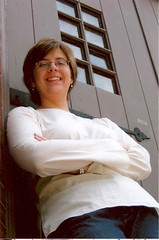Ethiopia Trip #7
March 29, 2007
Tonight I sat by the pool, bugs nibbling my ankles, and talked with a brilliant doctor about the reality of AIDS in Ethiopia. Dr. A is passionate and articulate, and his knowledge about this terrible epidemic was more than I could have researched on the web or read in a textbook. Because to Dr. A, AIDS is not just a topic, it is a reality.
Our conversation began the day before as we rode back from Walliso. Dr. A was visibly agitated by some things he learned on the trip, specifically the two mothers at one of the projects who had recently given birth to their babies without telling anybody that they had AIDS.
“It’s like they killed them,” he said sadly, shaking his head. By keeping their secret, they had more than tripled the chances that their infant children would contract this deadly disease. If they had breastfed, the chances tripled again.
“They still believe in this stigma, but it shouldn’t be. Every home has been touched by AIDS,” says Dr. A, his voice tinged with bitterness. “Everyone knows someone with AIDS. Everyone has attended a funeral of a family member or neighbor who died of AIDS. A stigma means it is something rare. I’m sorry to say, AIDS is not rare in Ethiopia anymore.”
We continued our conversation in the moonlight tonight, and Dr. A’s passion had not waned. AIDS is magnified by the poverty of Ethiopia. Malnutrition kills more quickly when a body is already weakened by AIDS. What’s the point of purchasing medicine when there is no money for food? Will a mother choose medical care for one of her children while letting the others starve? Should she?
Dr. A also shared with me that poverty means that the very people who try to stop AIDS are often put in danger. When he was doing his pediatric residency, he was assisting with the labor of a woman whose child would need immediate intervention after he was born. Dr. A asked for gloves, and was told there were none. The mother was HIV-positive. The child would die without his help. What choice did he have? So a few moments later, he held that bloody child in his bare hands and focused on bringing life—while trying to ignore the possibility of his own death.
He told us of a catholic nurse who cut the umbilical cord of a birthing mother with AIDS. A blood vessel ruptured, sending blood spraying, and hitting the nurse in the eye. When Dr. A met her, she was in the very same hospital where she once saved lives, fighting for her own. A simple pair of plastic glasses would have saved her life.
Tonight I sat by the pool, bugs nibbling my ankles, and talked with a brilliant doctor about the reality of AIDS in Ethiopia. Dr. A is passionate and articulate, and his knowledge about this terrible epidemic was more than I could have researched on the web or read in a textbook. Because to Dr. A, AIDS is not just a topic, it is a reality.
Our conversation began the day before as we rode back from Walliso. Dr. A was visibly agitated by some things he learned on the trip, specifically the two mothers at one of the projects who had recently given birth to their babies without telling anybody that they had AIDS.
“It’s like they killed them,” he said sadly, shaking his head. By keeping their secret, they had more than tripled the chances that their infant children would contract this deadly disease. If they had breastfed, the chances tripled again.
“They still believe in this stigma, but it shouldn’t be. Every home has been touched by AIDS,” says Dr. A, his voice tinged with bitterness. “Everyone knows someone with AIDS. Everyone has attended a funeral of a family member or neighbor who died of AIDS. A stigma means it is something rare. I’m sorry to say, AIDS is not rare in Ethiopia anymore.”
We continued our conversation in the moonlight tonight, and Dr. A’s passion had not waned. AIDS is magnified by the poverty of Ethiopia. Malnutrition kills more quickly when a body is already weakened by AIDS. What’s the point of purchasing medicine when there is no money for food? Will a mother choose medical care for one of her children while letting the others starve? Should she?
Dr. A also shared with me that poverty means that the very people who try to stop AIDS are often put in danger. When he was doing his pediatric residency, he was assisting with the labor of a woman whose child would need immediate intervention after he was born. Dr. A asked for gloves, and was told there were none. The mother was HIV-positive. The child would die without his help. What choice did he have? So a few moments later, he held that bloody child in his bare hands and focused on bringing life—while trying to ignore the possibility of his own death.
He told us of a catholic nurse who cut the umbilical cord of a birthing mother with AIDS. A blood vessel ruptured, sending blood spraying, and hitting the nurse in the eye. When Dr. A met her, she was in the very same hospital where she once saved lives, fighting for her own. A simple pair of plastic glasses would have saved her life.



0 Comments:
Post a Comment
<< Home